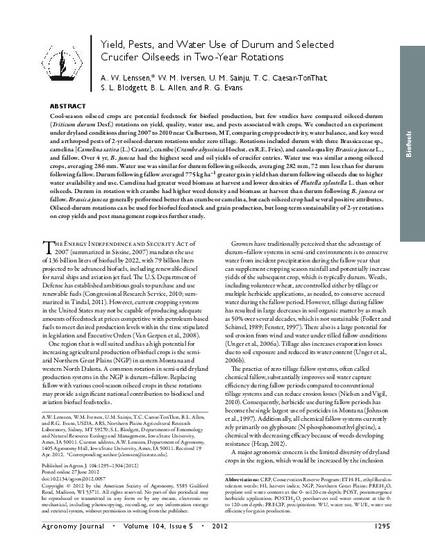
Cool-season oilseed crops are potential feedstock for biofuel production, but few studies have compared oilseed-durum (Triticum durum Desf.) rotations on yield, quality, water use, and pests associated with crops. We conducted an experiment under dryland conditions during 2007 to 2010 near Culbertson, MT, comparing crop productivity, water balance, and key weed and arthropod pests of 2-yr oilseed-durum rotations under zero tillage. Rotations included durum with three Brassicaceae sp., camelina [Camelina sativa (L.) Crantz], crambe (Crambe abyssinica Hochst. ex R.E. Fries), and canola-quality Brassica juncea L., and fallow. Over 4 yr, B. juncea had the highest seed and oil yields of crucifer entries. Water use was similar among oilseed crops, averaging 286 mm. Water use was similar for durum following oilseeds, averaging 282 mm, 72 mm less than for durum following fallow. Durum following fallow averaged 775 kg ha−1 greater grain yield than durum following oilseeds due to higher water availability and use. Camelina had greater weed biomass at harvest and lower densities of Plutella xylostella L. than other oilseeds. Durum in rotation with crambe had higher weed density and biomass at harvest than durum following B. juncea or fallow. Brassica juncea generally performed better than crambe or camelina, but each oilseed crop had several positive attributes. Oilseed-durum rotations can be used for biofuel feedstock and grain production, but long-term sustainability of 2-yr rotations on crop yields and pest management requires further study.
Available at: http://works.bepress.com/sue_blodgett/4/

This article is from Agronomy Journal 04 (2012): 1295–1304, doi:10.2134/agronj2012.0057.